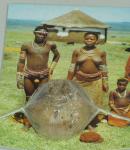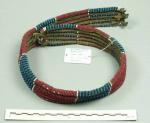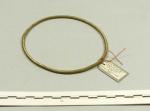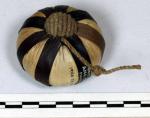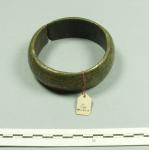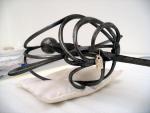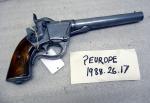
helen
For Deletion-
Posts
166 -
Joined
-
Last visited
Content Type
Profiles
Forums
Blogs
Gallery
Events
Store
Everything posted by helen
-
-
-
-
-
-
-
-
-
-
-
-
Hello, At Mervyn's request, here is a selection of the Zulu material held at the Pitt Rivers Museum in Oxford. Only a minority of the objects are weapons but I would thought I would post the lot as they make a good cultural 'bundle'. The majority of our Zulu items are headrests, bracelets/armlets, and bead belts. The dates vary considerably - ignore any dates in museum numbers in the photographs - they can often be years later that than the date of collection. Some do date to the time of the Zulu Wars, acquired and brought back by British soldiers or the families of civil servicemen in S. Africa. Others are much later (post ww2). If you have any specific queries about an object, please ask. Otherwise, any comments about any of the items would be interesting to hear. Enjoy! Helen (P.S. The boring bit but I am supposed to say it - 'All images are under copyright as property of the University of Oxford and should not be reproduced or distributed either electronically or in print without full permission'. Thank you!
-
hello all, thanks for your posts! The idea of using it on a camel is interesting but probably not tenable - seriously, this thing is HEAVY. I'm fairly fit and strong but struggle to lift it on my own, let alone raise it to shoulder level. It's heavier than some solid iron Tudor hand-canons I've handled. But if it's true that some camel saddles were modified to be mounted with a gun on a spike/pivot, I'd be keen to see them. The gun is now out of store so I will be able to take some stats - pictures of marks (there is one that is repeated over the plate, butt and barrel but difficult to describe), measurements of the bore and also weight - and post them up next week. Cheers! Helen
-
Jonathan and Henry - thank you for the tips about where to go for potentially more info. Went to the Wallace Collection in London at weekend - never been there before - wow! They had scores of these type of rapiers and other beautiful renaissance cinquedeas and main gauches etc on display. I tried to see if the rapiers had inscriptions down the blade like this one and some did but they were mostly acronyms or a type of Latin shorthand, which I couldn't decipher. The catalogues indicated that they were predominantly Spanish though....
-
Peter, wonderful to hear of your time in Africa - even though those folk do sound rather intimidating! - as it helps bring such weapons to life. Thank you for filling us in on the tribes customs and your own experiences - you're probably right about the Fulani - I went back to the source and read that during certain dances performed to reinforce group/clan alliances they simply carried swords and spears that were 'Tuareg-style' (not necessarily their own cultural property nor necessarily a common practice). So Tuareg looks plausible but even so, I'm not totally sure - the Tuareg spear butts seem very slim and only flare out quite near the end, not have the elongated tapering section as on Brian's example. What do you think? But anyway, it's perhaps the best guess so far...
-
Mervyn, Well, yes, I'm in my twenties so perhaps wouldn't remember the place but when you mentioned Burlington, something clicked in my memory that I'd read. I looked through a publication by our director, who used to work at the British Museum, and think I've found what we're looking for! - Number 6, Burlington Gardens, used to be occupied by the British Museum's Ethnography Department, although it was not purpose-built as a museum. Designed in the 1860s by James Pennethorne (adopted son of the architect John Nash), its first tenants were London University, hence the statues along the fa?ade of luminaries ranging from Plato to Adam Smith. Subsequently, the building housed the Civil Service Commission, before hosting the Ethnography Department when it migrated from the British Museum's overcrowded Bloomsbury site in 1970. It became known as the Museum of Mankind. At the end of 1997 it closed and the Department moved back into the main British Museum site in Bloomsbury began. (In 2005 the building was brought back into use by the Royal Academy, the tenant of the original wing of Burlington House and the wing which lies between the two buildings. It is used mainly by the Royal Academy Schools now). Hope that's solved the puzzle and at least it means the collections weren't disseminated - they're still in the hands of the BM (although I still think the Horniman tops it in the 'weird and wonderful' stakes! ) Helen
-
Mervyn, I'm not sure I've ever heard of an 'Ethnographic Museum' in London per se...there is the Horniman in London and outside the city other institutions with ethnographic collections such as the museums in Brighton and Saffron Walden. Perhaps it is known under a different name now?
-
By the way, I'm not implying that this is a 'fake' or 'imitation' sword - it's still a lovely historical piece and very finely made, i just want to establish date and provenance if possible! Thanks
-
hello! I just wanted to show you all this rapier in case any of you can shed further light on a) its date and b) where it's from. It says on the blade 'petrus in toledo' but am aware that, rather like fake Rolexes, Toledo swords were the best in the business and often ripped off. We had a researcher in not long ago who thought it might be German, due to the lack of genuine Toledo marks. As to the date, our original catalogue entry of 1892 states it is late C16th but this researcher thought it is more stylistically C17th. Any suggestions or input on this greatly received. Thanks Helen
-
well, I have no idea what this is but I know what it reminds me of - a spear butt, not a spear head! Spears used by the Tuareg and also the Bororo Fulani people of Northern Nigeria have a similar, spatula-like butt. Mervyn's reference to the Congo might be closer to the mark - the Bushoong (Kuba) people historically used a warsword called an 'ilwoon' with a similar-shaped blade. It was also worn as part of a dance costume at the funeral of high-ranking tribesmen. However, I've no idea if this shape extended to spears. I have never seen an Inuit weapon or implement of this type and it is rare to find Inuit items of a historical nature containing so much steel. An interesting object, whatever it is!
-
Mervyn, Thanks for the tip about the topic in the 'Lounge' - I'm sure it would make interesting reading for me. One of the main problems for museums that are not subject-specific (i.e. Royal Armouries) and instead are interested in weapons from a social history or human technology/anthropological point of view (like us!) is that we would love more donations of such material but lack the capacities to store it to sufficient legal requirements. We have gun safes but they are nearly full and buying new ones is not only expensive but always seems to gets pushed to the bottom of the 'we need' pile of priorities. The alarm system for the new firearms display case was incredibly costly to buy and install also. As we don't charge entry to the museum, dispensable money for such things is hard and slow to come by. There is also the problem that a lot of people only want to donate something to a museum if they can be guaranteed it will go on public display and not in a box in reserve collections. Unfortunately, it's difficult - if not impossible - for museums to make that sort of promise. Anyway, I can reiterate this on-topic! As for the unanswered posts - please do 'have a stab'. I would be interested in hearing your thoughts as you obviously have a wide field of knowledge and after all, it means the topic shoots back up the list of 'most recent' posts and therefore might catch the eye of a new reader... Helen
-
Lovely gun. I won't be able to tell you anything you don't already know as we've probably researched the same sources. As far as I am aware, Tranter made three models all using double triggers. It was only later that he began work on a single-trigger double-action revolver - the 'fourth' model. We have a double-trigger example in the Museum. As your extract says, in 1863, Tranter secured some British contracts (your weapon doesn't look too dissimilar to the 1863 model?) and his factory in the UK supplied to overseas markets - perhaps explaining its appearance in South Africa? Don't think there was much in the way of new models after 1879 so presumably 1863-1879 is your window! Have a look here: http://www.firearmsmuseum.org.au/TranterHi...wt_hist_fra.htm - the descriptions and ammo specs may be enough to decipher the age and model of your weapon.
-
hi everyone, We have a number of identified 'replica' firearms in our Museum collection. A fair number have been identified (by a curator many years ago) as having been made in Spain. Does anyone know anything about the replica gun industry in Spain, if the country is/was known for such an industry, when it started and if it continues today? Initial searches on google didn't yield much. Any info, references or thoughts welcome. Here is an example, a Spanish-made replica Sharps mechanism pistol. Model is ?1850s, replica date unknown? (The 1988 date on the label is the date the police gave it to the Museum following a public weapons amnesty). Many thanks, Helen P.S. What differentiates a replica and and a reproduction when it comes to firearm manufacture?
-
Kjell, yes, interesting point about the similarity. Here's a Scots dirk we have (though nowhere near as nice as yours!) Helen



